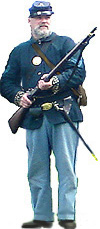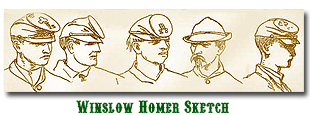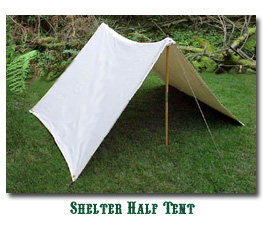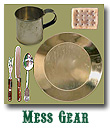Uniform
& Equipment
 he recreated 28th Massachusetts Volunteer
Infantry is continuously seeking to improve its portrayal of the
original regiment and encourages its members to purchase items with
authenticity in mind. We understand that the costs of outfitting
oneself can mount up quickly, particularly for new recruits. he recreated 28th Massachusetts Volunteer
Infantry is continuously seeking to improve its portrayal of the
original regiment and encourages its members to purchase items with
authenticity in mind. We understand that the costs of outfitting
oneself can mount up quickly, particularly for new recruits.
 To accommodate a range of approaches to
reenacting - from raw recruit on a budget to veteran for whom money is
no object - we have developed a list of recommended
sutlers
on both ends of the spectrum: from painstaking craftsmen who are known
throughout the hobby for their highly authentic uniforms, accoutrements
and weapons, to full-line sutlers who meet minimum standards of
historical accuracy. To accommodate a range of approaches to
reenacting - from raw recruit on a budget to veteran for whom money is
no object - we have developed a list of recommended
sutlers
on both ends of the spectrum: from painstaking craftsmen who are known
throughout the hobby for their highly authentic uniforms, accoutrements
and weapons, to full-line sutlers who meet minimum standards of
historical accuracy.
Many new members start with lower cost items
that meet minimum standards of authenticity, then decide to "move up"
in the future. If you can, however, we encourage you to buy more
authentic goods from the very beginning. This will be more
cost-effective in the long run, since it will spare you from buyer's
remorse and the inevitable decision to upgrade your kit later.
What
You'll Need
The basic required "kit" for portraying a
soldier in the 28th Massachusetts includes the following items:
 Federal issue forage cap
(dark or indigo
blue) Federal issue forage cap
(dark or indigo
blue)- State issue forage cap with McDowell visor
(dark or indigo blue)
- Federal fatigue blouse ("sack coat," dark or
indigo blue)
with four brass buttons
- Federal trousers, foot pattern (sky blue)
- Issue muslin shirt (or other period pattern)
- Issue socks (gray or rag wool)
- Issue M1851 Jefferson brogans (shoes)
- USM1855 cartridge box, .58 caliber, mid-war
model
(black leather)
- Cartridge box sling (black leather)
- US oval cartridge box plate (brass)
- US round eagle box sling plate (brass)
- USM1856 waist belt (black leather)
- US Oval waist belt plate (brass)
- USM1855 bayonet scabbard
(black leather, one-piece Springfield style)
- USM1850 Cap pouch (black leather)
- M1853 three-band .577 caliber Enfield rifle
musket and bayonet
- Musket sling for M1853 Enfield (untreated
leather)
- Haversack, U.S. regulation wartime issue
(black tarred canvas)
- USM1858 smooth side canteen (jean cloth or
dark blue wool cover) with strap (leather preferred over cotton drill
or linen)
More
of the Basics
Here are a few things you should know and
bear in mind as you prepare to "kit up" and field with the 28th
Massachusetts:
- Musket.
This is the most expensive item you will purchase - generally $600 or
more - so shop around carefully. Armisport makes the best currently
available reproduction. Order a bayonet at the
same time you buy your rifle to ensure a proper
fit, but be sure to specify that you want a one-piece Springfield-style
scabbard.
 The
28th was issued the .577 caliber Enfield
three-band rifle musket
in late 1861. Most of our members carry Enfields, although some have
chosen the more costly .58 caliber Springfield. No other weapons may be
carried by members who portray enlisted men. Officers carry swords but,
for safety reasons, do not use pistols. The
28th was issued the .577 caliber Enfield
three-band rifle musket
in late 1861. Most of our members carry Enfields, although some have
chosen the more costly .58 caliber Springfield. No other weapons may be
carried by members who portray enlisted men. Officers carry swords but,
for safety reasons, do not use pistols.
- Ammunition.
You will need to purchase gunpowder and .58 caliber musket percussion
caps, which is not as easy as it used to be. Since 9/11, fewer sporting
goods stores, gun dealers and mail order suppliers carry black powder
supplies. You will need to roll an adequate supply of blank cartridges
before fielding. Expect to fire as few as 20 to 30 rounds at a living
history event to as many as 100 or more over the course of a major
battle weekend. A blank cartridge is simply a paper tube filled with 50
to 60 grains of powder, twisted off at one end and folded at the other.
You may download a template and instructions in Microsoft Word
or PDF
format. Many sutlers offer pre-rolled tubes and some sell blank
cartridges in period-authentic wrappers, but making your own is more
economical.
- Suspenders.
You may purchase an authentic pair of linen suspenders with leather
ends from most sutlers. Get used to the idea that linen suspenders do
not give when you sit, so it's easy to pop their buttons if you don't
have them adjusted to the proper length.
- Forage
Caps. You will need two: a
standard federal issue cap for "generic" Union infantry impressions at
larger battle events and a state-issue "McDowell" cap for when we
portray our own unit. The only significant difference is that the
McDowell's visor is rounded rather than squared. Cap decorations such
as 2nd Corps badges (red trefoils)and brass regimental and company
designations are
 left to individual taste.The prevalence
of hat ornaments during the war is debatable, but a sketch by Winslow
Homer clearly shows that soldiers in the 28th Massachusetts used them.
Most of our current members have stopped adorning their caps with the
popular Irish harps since there is little evidence of their actual use
during the war. left to individual taste.The prevalence
of hat ornaments during the war is debatable, but a sketch by Winslow
Homer clearly shows that soldiers in the 28th Massachusetts used them.
Most of our current members have stopped adorning their caps with the
popular Irish harps since there is little evidence of their actual use
during the war.
- Eyewear.
If you wear eyeglasses to correct your vision, you will need
period-appropriate spectacle frames. Reproductions are acceptable,
since antique eyeglass frames can be expensive and fragile. Many
sutlers carry reproductions of varying quality. Another option is
contact lenses, which are acceptable in our unit and may create the
most authentic look from a few paces away, since most soldiers did not
wear spectacles in the field.

- Knapsack.
Although not required, most members eventually pick one up, anyway,
because it can provide a convenient and authentic way to pack gear for
trips. A knapsack can also serve as a nice pillow in camp, and
occasionally we do go on marches that require carrying full packs or
blanket rolls. If you do purchase a knapsack, it needs to be the U.S.
1851 double bag model, wartime issue.
- Great
Coat. We do not require an
overcoat as basic equipment, but strongly suggest that you eventually
purchase one for those cold days in spring or fall. Period style rag
wool gloves and scarves also come in handy when temperatures drop.
- Blankets
and Ponchos. Most of us use gray
wool issue blankets, although tan blankets were also common, as were
various blankets and quilts sent from home. Infantrymen were also
issued black rubber "gum" blankets to use as ground cloths. Some of our
men opt for cavalry issue ponchos (gum blankets with neck openings),
since these are ideal for wearing over uniforms in rainy weather.
- Tents.
Since most battle reenactments portray the unit on campaign, shelter
halves or "dog tents" are preferred at most events. "A" or
 wedge
tents are considerably larger and
more comfortable, particularly in the rain, but are less useful for
living history purposes since they were issued primarily when a
regiment was training at home or in winter quarters. While tents are
sometimes available for recruits to borrow, we encourage our members to
purchase shelter halves as soon as they can afford to do so. When an
"A" tent has to be used, at least two men should share it. Up to five
men could be assigned to a single wedge tent during the war. wedge
tents are considerably larger and
more comfortable, particularly in the rain, but are less useful for
living history purposes since they were issued primarily when a
regiment was training at home or in winter quarters. While tents are
sometimes available for recruits to borrow, we encourage our members to
purchase shelter halves as soon as they can afford to do so. When an
"A" tent has to be used, at least two men should share it. Up to five
men could be assigned to a single wedge tent during the war.
 Mess Gear.
Soldiers bring and prepare their own food when they go to events. You
will need at least some of the following to cook over a campfire: tin
cup and plate, mucket (tin cup with lid and bale), small skillet, and
squirrel cooker (a wrought iron fork and holder). Some members own
grates and are generally willing to share them. Plan on carrying at
least a tin cup, tin plate, and utensils (fork, knife and spoon). Mess Gear.
Soldiers bring and prepare their own food when they go to events. You
will need at least some of the following to cook over a campfire: tin
cup and plate, mucket (tin cup with lid and bale), small skillet, and
squirrel cooker (a wrought iron fork and holder). Some members own
grates and are generally willing to share them. Plan on carrying at
least a tin cup, tin plate, and utensils (fork, knife and spoon).
Recommended
Sutlers >
|


